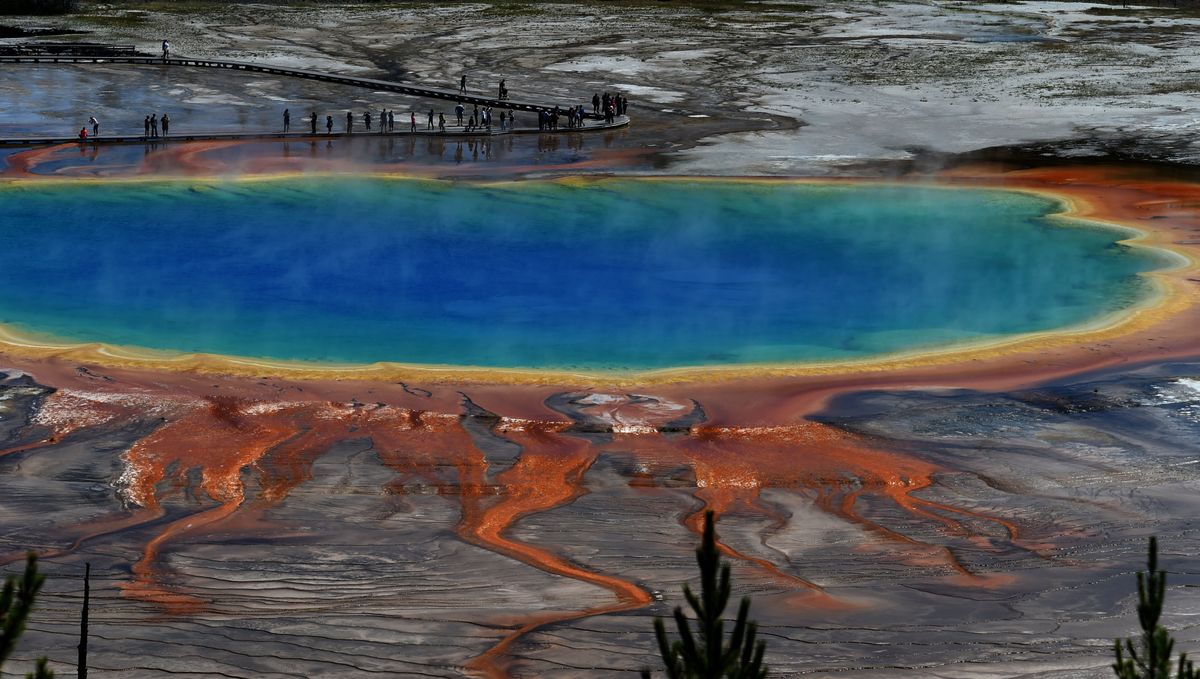Ask Dr. Universe: Why do bacteria in the Yellowstone hot springs make the water different colors?

Washington State University
Dr. Universe: Why do bacteria in the Yellowstone hot springs make the water different colors? – Ava, 9, Kennewick
Dear Ava,
One of the most eye-catching hot springs in Yellowstone National Park is the bright and colorful Grand Prismatic Spring. It’s blue in the middle with bands of colors ranging from green and yellow to orange and reddish-brown.
My friend Peter Larson is a geologist at Washington State University who is very curious about hot springs. He spent much of his research career in Yellowstone National Park.
Larson said that when we look into the hot spring, we are seeing the colors of tiny living things called cyanobacteria.
In the middle of the hot spring, there aren’t any cyanobacteria. The water is nearly boiling, and they can’t survive the high temperatures.
But as we move out from the middle of the hot spring, the water gets a bit cooler. We find a lot of cyanobacteria showing off their green and yellow colors.
These colors come from something called pigments. In fact, a lot of the colors we find in nature come from pigments. You even have pigments in your hair, eyes and skin. Pigments absorb certain waves of light from the sun and reflect others, which helps to give us the colors we see.
One very important pigment that cyanobacteria have is called chlorophyll. It not only gives them their yellow and green colors but also helps them survive.
Cyanobacteria can use their chlorophyll molecules to absorb energy from sunlight – an important ingredient they need to make their own food. When we see a lot of green or yellow in the hot spring, we know that the cyanobacteria are alive and well.
Some cyanobacteria also make pigments such as carotenoids, which help them use chlorophyll. Carotenoids can also provide them with some protection from the sun. When we see orangish parts of the hot springs, there are likely some carotenoid-making cyanobacteria in the water.
At the very edge of some hot springs, we can also see some reddish-brown colors. This is the coolest part of the spring and home to a diverse community of cyanobacteria and other kinds of bacteria that give off red and brown colors. Even though this is the coolest part of the hot spring, it’s still really hot – around 131 degrees.
Organisms that live in extreme environments, including some of the cyanobacteria in hot spring, are called extremophiles. Larson said hot springs and these extremophiles often get a lot of attention when scientists are wondering about the origins of life on Earth.
One idea some scientists have proposed is that hot springs provided just the right conditions for early life on Earth to develop. Larson also adds that scientists who are curious about life on Mars often look to the old hot springs on the Red Planet as they search for evidence of life.
Larson and I want to thank you for your great science question. It’s a good reminder that a single question can take us into many different scientific fields. From geology to biology to astrophysics and beyond, it sure is an amazing world to explore.
Sincerely,
Dr. Universe
Submit a question at askdruniverse.wsu.edu/ask for a chance to be featured in a future video, podcast or Q&A post.